The Economics and Statistics Division maintains archives of previous publications for accountability purposes, but makes no updates to keep these documents current with the latest data revisions from Statistics Canada. As a result, information in older documents may not be accurate. Please exercise caution when referring to older documents. For the latest information and historical data, please contact the individual listed to the right.
<--- Return to Archive
For additional information relating to this article, please contact:
June 20, 2019EMPLOYMENT INSURANCE, APRIL 2019 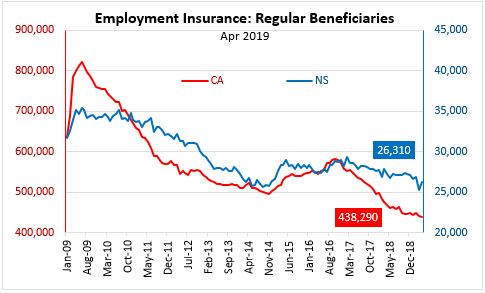
In April 2019, the number (seasonally adjusted) of Nova Scotians receiving regular Employment Insurance (EI) benefits rose by 1,050 (+4.2 per cent) from the previous month to 26,310 and decreased by 960 persons (-3.5 per cent) from April 2018. Following an increase through much of 2016, the number of EI beneficiaries in Nova Scotia has been trending down since the beginning of 2017.
The number (seasonally adjusted) of Canadians receiving regular EI benefits in April 2019 decreased by 0.7 per cent (3,240 persons) to 438,290. The number of regular EI beneficiaries decreased by 31,580 (-6.7 per cent) from April 2018.
Year-to-date, the number of Nova Scotians receiving regular EI benefits declined by 4.2 per cent. Nationally, EI usage has declined 8.1 per cent compared to the first four months of 2018. All provinces have seen declines in year-to-date EI usage, with largest decline in Alberta (-12.6 per cent) and the smallest in Manitoba (-1.7 per cent).
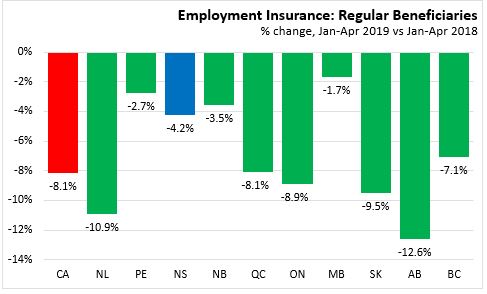
AGE
The bulk of EI beneficiaries in Nova Scotia are aged 25 to 54, who also account for the largest share of the labour force. In April, the number of beneficiaries aged 25-54 rose by 880 persons, month-to-month. The number of beneficiaries aged 55 and older was up by 320 persons, and the number of beneficiaries aged 15-24 was down by 160 persons compared to the previous month.
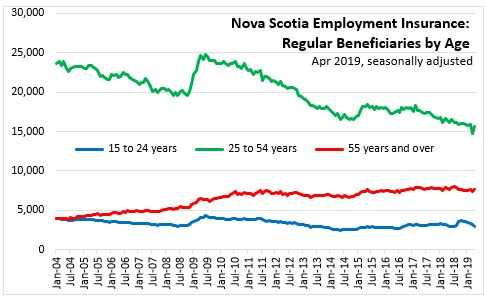
Measured as a share of the labour force, EI usage is more prevalent among older workers (6.6 per cent) than it is among youth (4.0 per cent) or core aged workers (5.1 per cent).

EI BENEFICIARIES AS A SHARE OF THE UNEMPLOYED BY PROVINCE
The number (seasonally adjusted) of Nova Scotians receiving regular EI benefits in April 2019 accounted for 5.3 per cent of the total labour force. In Canada, the number of EI beneficiaries accounted for 2.2 per cent of the total labour force.
In Nova Scotia, EI beneficiaries accounted for 76.5 per cent of the unemployed, compared to a Canadian rate of 37.8 per cent. Across the country, EI beneficiaries accounted for the highest share of the unemployed in the Atlantic provinces, led by Newfoundland and Labrador and Prince Edward Island. EI beneficiaries accounted for the lowest share of the unemployed in Ontario and Alberta.
Note that due to differences in estimation methodology, it is possible for the reported number of EI beneficiaries to exceed the reported number of unemployed in a given jurisdiction.
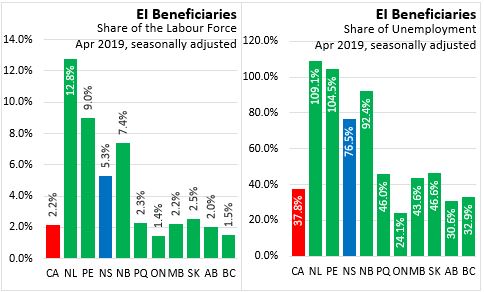
COUNTIES
In the first four months of 2019, EI usage (regular beneficiaries, unadjusted) was up in Guysborough, Antigonish, Inverness, Richmond, Cape Breton and Victoria counties compared to the same period last year. Decreases were seen in all other counties, with the largest decline in percentage terms in Shelburne (-20.6 per cent).

OCCUPATION
Nova Scotia's EI usage by occupation (seasonally adjusted) is highest among trades/transport/equipment operators (8,240 in April), followed by sales and service occupations, natural resources, manufacturing, and occupations in business, finance and administration.
Compared to January-April 2018, usage is up in business and finance (+6.2 per cent), art, culture, recreation and sports (+31.2 per cent), and in unclassified occupations. All other occupation categories have seen a decline in the number of EI beneficiaries in year-to-date terms.
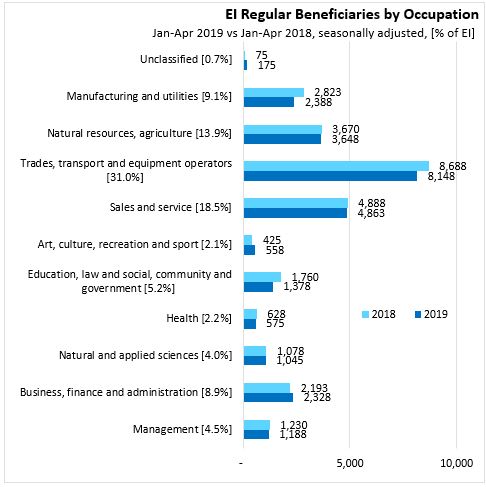
With this month's release, EI statistics were revised back to January 2000. These revisions include updates to the geography boundaries to the 2016 Standard Geographical Classification, occupations were updated to the 2016 National Occupation Classification, and the seasonal adjustment factor was revised to reflect the most recent seasonal factors.
Legislative changes to the EI program came into effect in July 2016. While some of these changes affected all EI regions across Canada, eligible claimants in the 15 regions that posted notable increases in unemployment received additional weeks of regular benefits starting in July. More information on the 2016 EI changes is available on Employment and Social Development Canada's (ESDC) website. As a result of the changes to the EI program, historical comparisons are not recommended, except in areas outside of the 15 EI regions where eligible claimants received additional weeks of benefits. These 15 EI regions are Newfoundland and Labrador, Northern Ontario, Sudbury, Northern Manitoba, Southern Saskatchewan, Northern Saskatchewan, Saskatoon, Southern Alberta, Northern Alberta, Calgary, Edmonton, Southern Interior British Columbia, Northern British Columbia, Whitehorse and Nunavut.
Source: Statistics Canada
Table 14-10-0011-01 Employment insurance beneficiaries (regular benefits) by province and territory, monthly, seasonally adjusted
Table 14-10-0337-01 Employment insurance beneficiaries (regular benefits) by province, territory and occupation, monthly, seasonally adjusted
Table 14-10-0323-01 Employment insurance beneficiaries by census division, monthly, unadjusted for seasonality
<--- Return to Archive